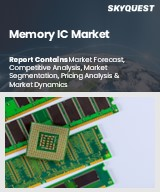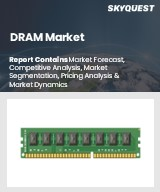
|
시장보고서
상품코드
1642543
다이나믹 랜덤 액세스 메모리 시장 : 유형별, 기술별, 최종사용자별, 지역별(2025-2033년)Dynamic Random Access Memory Market by Type, Technology, End User, and Region 2025-2033 |
||||||
세계의 다이나믹 랜덤 액세스 메모리(DRAM) 시장 규모는 2024년에 1,354억 달러에 달했습니다. 향후 IMARC Group은 2033년까지는 3,590억 달러에 달하며, 2025-2033년의 성장률(CAGR)은 11.4%에 달할 것으로 예측하고 있습니다. 태블릿, 노트북, 스마트폰 등의 보급과 함께 CE(Consumer Electronics) 산업의 부상이 주로 시장을 촉진하고 있습니다. DRAM 시스템에 대한 AI의 통합은 중요한 시장 동향입니다. 현재, 아시아태평양이 최대 시장 점유율을 차지하고 있으며, 이는 CE(Consumer Electronics)의 급속한 개발에 의한 것입니다.
동적 랜덤 액세스 메모리(Dynamic Random Access Memory, DRAM)는 각 비트의 데이터를 메모리 셀에 저장하는 반도체 메모리의 일종입니다. 집적회로 내의 커패시터에 일련의 전하로 데이터를 저장합니다. 컴퓨터, 서버, 스마트폰, 태블릿, 워크스테이션 등에 사용되는 일반적인 랜덤 액세스 메모리(RAM)의 일종으로, 하나의 트랜지스터로 구성된 단순한 설계로 프로그램 실행 중에 메모리를 업데이트하거나 삭제할 수 있습니다. 정적 랜덤 액세스 메모리(SRAM)에 비해 DRAM은 상대적으로 비용 효율적이며, 고밀도이기 때문에 하나의 장비에 많은 양의 메모리를 탑재할 수 있습니다. 그 결과, DRAM은 IT/통신, 국방/항공우주, 미디어/엔터테인먼트, 의료/헬스케어, CE(Consumer Electronics) 등 다양한 산업 분야에서 폭넓게 사용되고 있습니다.
동적 랜덤 액세스 메모리(DRAM) 시장 동향 :
세계 소비자 전자제품 산업의 괄목할 만한 성장은 시장 전망을 밝게 하는 중요한 요인 중 하나입니다. 이와 함께 고급 용도를 실행하고 원활한 사용자 경험을 제공하기 위해 대용량의 메모리를 필요로 하는 스마트폰, 태블릿, 노트북 및 기타 전자기기의 인기가 높아지면서 시장 성장을 촉진하고 있습니다. 또한 DRAM 데이터센터가 자주 액세스하는 데이터와 명령어를 저장하기 위해 DRAM 데이터센터가 널리 채택되면서 처리 속도와 데이터 전송 속도가 빨라진 것도 성장을 가속하는 요인으로 작용하고 있습니다. 이와는 별도로, DRAM의 타이밍과 전압 설정을 동적으로 조정하여 성능을 최적화하고 전력 소비를 최소화하기 위해 사용되는 인공지능(AI)의 통합이 시장 성장을 가속하고 있습니다. 또한 제조업체들은 DRAM의 성능과 효율성을 향상시키기 위해 클럭 속도 향상, 전압 감소, 고급 절전 기능 구현 등 다양한 첨단 기술을 도입하는 데 주력하고 있으며, 이는 시장 성장에 긍정적인 영향을 미치고 있습니다. 기타 클라우드 컴퓨팅 수요 증가, 고성능 DRAM을 필요로 하는 5G, 가상현실, 증강현실(VR/AR) 등 급속한 기술 발전, 고메모리 탑재 핸드헬드 디바이스 수요 증가, 광범위한 연구개발 활동, 하이브리드 디바이스 및 초박형 노트북 등 컴퓨팅 분야의 새로운 디바이스 출시 등이 시장 성장을 촉진하고 있습니다.
목차
제1장 서문
제2장 조사 범위와 조사 방법
- 조사의 목적
- 이해관계자
- 데이터 소스
- 1차 정보
- 2차 정보
- 시장 추정
- 보텀업 어프로치
- 톱다운 어프로치
- 예측 조사 방법
제3장 개요
제4장 서론
- 개요
- 주요 업계 동향
제5장 세계의 다이나믹 랜덤 액세스 메모리(DRAM) 시장
- 시장 개요
- 시장 실적
- COVID-19의 영향
- 시장 예측
제6장 시장 내역 : 유형별
- 동기 DRAM
- 시장 동향
- 시장 예측
- 버스트 확장 데이터
- 시장 동향
- 시장 예측
- 확장 데이터 출력
- 시장 동향
- 시장 예측
- 출력 비동기 DRAM
- 시장 동향
- 시장 예측
- 고속 페이지 모드
- 시장 동향
- 시장 예측
제7장 시장 내역 : 기술별
- DDR4
- 시장 동향
- 시장 예측
- DDR3
- 시장 동향
- 시장 예측
- DDR5/GDDR5
- 시장 동향
- 시장 예측
- DDR2
- 시장 동향
- 시장 예측
제8장 시장 내역 : 최종사용자별
- IT·통신
- 시장 동향
- 시장 예측
- 방위·항공우주
- 시장 동향
- 시장 예측
- 미디어·엔터테인먼트
- 시장 동향
- 시장 예측
- 의료·헬스케어
- 시장 동향
- 시장 예측
- CE(Consumer Electronics)
- 시장 동향
- 시장 예측
제9장 시장 내역 : 지역별
- 북미
- 미국
- 캐나다
- 아시아태평양
- 중국
- 일본
- 인도
- 한국
- 호주
- 인도네시아
- 기타
- 유럽
- 독일
- 프랑스
- 영국
- 이탈리아
- 스페인
- 러시아
- 기타
- 라틴아메리카
- 브라질
- 멕시코
- 기타
- 중동 및 아프리카
- 시장 동향
- 시장 내역 : 국가별
- 시장 예측
제10장 촉진요인, 억제요인, 기회
- 개요
- 촉진요인
- 억제요인
- 기회
제11장 밸류체인 분석
제12장 Porter's Five Forces 분석
- 개요
- 바이어의 교섭력
- 공급 기업의 교섭력
- 경쟁의 정도
- 신규 진출업체의 위협
- 대체품의 위협
제13장 가격 분석
제14장 경쟁 구도
- 시장 구조
- 주요 기업
- 주요 기업의 개요
- ATP Electronics Inc.(Orient Semiconductor Electronics Ltd.)
- Etron Technology Inc.
- Integrated Silicon Solution Inc.
- Kingston Technology Corporation
- Micron Technology Inc.
- Nanya Technology Corporation
- Powerchip Semiconductor Manufacturing Corp.
- Samsung Electronics Co. Ltd
- SK Hynix Inc.
- Transcend Information Inc.
- Winbond Electronics Corporation
The global dynamic random access memory (DRAM) market size reached USD 135.4 Billion in 2024. Looking forward, IMARC Group expects the market to reach USD 359.0 Billion by 2033, exhibiting a growth rate (CAGR) of 11.4% during 2025-2033. The rising consumer electronics industry, along with the widespread adoption of tablets, laptops, smartphones, etc., is primarily driving the market. The integration of AI into DRAM systems is a significant market trend. At present, Asia Pacific holds the largest market share, driven by rapid development in consumer electronics.
Dynamic random access memory (DRAM) is a type of semiconductor memory that stores each bit of data in a memory cell. It stores data as a series of electrical charges in capacitors within an integrated circuit. It is a common type of random access memory (RAM) that is used in personal computers, servers, smartphones, tablets, and workstations. DRAM is simply designed only requiring one transistor and allows memory to be refreshed and deleted while a program is running. As compared to static random access memory (SRAM), DRAM is relatively cost-efficient and high-density, allowing large amounts of memory to be installed in a single device. As a result, DRAM finds extensive applications across the IT and telecommunication, defense and aerospace, media, and entertainment, medical and healthcare, and consumer electronics industries.
Dynamic Random Access Memory (DRAM) Market Trends:
The significant growth in the consumer electronics industry across the globe is one of the key factors creating a positive outlook for the market. In line with this, the growing popularity of smartphones, tablets, laptops, and other electronic devices that require large amounts of memory to run advanced applications and provide a seamless user experience, is favoring the market growth. Moreover, the widespread adoption of DRAM data centers to store frequently accessed data and instructions allows for faster processing speeds and a high data transfer rate, which in turn is acting as another growth-inducing factor. Apart from this, the integration of artificial intelligence (AI) that is used to dynamically adjust the DRAM's timing and voltage settings to optimize performance and minimize power consumption is providing a thrust to the market growth. Additionally, manufacturers are focusing on the introduction of various advanced techniques to improve the performance and efficiency of DRAM, such as increasing the clock speed, reducing the voltage, and implementing advanced power-saving features, which in turn is positively influencing the market growth. Other factors, including increasing demand for cloud computing, rapid technological advancements such as 5G, virtual reality, and augmented reality (VR/AR) that require high-performance DRAM, rising demand for high-memory handheld devices, extensive research and development (R&D) activities, and launch of new devices in the computing field, such as hybrid devices and ultra-thin notebooks, are supporting the market growth.
Global Dynamic Random Access Memory (DRAM) Industry Segmentation:
Type Insights:
- Synchronous DRAM
- Burst Extended Data
- Output Extended Data
- Output Asynchronous DRAM
- Fast Page Mode
Technology Insights:
- DDR4
- DDR3
- DDR5/GDDR5
- DDR2
End User Insights:
- IT and Telecommunication
- Defense and Aerospace
- Media and Entertainment
- Medical and Healthcare
- Consumer Electronics
Regional Insights:
- North America
- United States
- Canada
- Europe
- Germany
- France
- United Kingdom
- Italy
- Spain
- Russia
- Others
- Asia-Pacific
- China
- Japan
- India
- South Korea
- Australia
- Indonesia
- Others
- Latin America
- Brazil
- Mexico
- Others
- Middle East and Africa
- The report has also provided a comprehensive analysis of all the major regional markets, which include North America (the United States and Canada); Europe (Germany, France, the United Kingdom, Italy, Spain, Russia, and others); Asia Pacific (China, Japan, India, South Korea, Australia, Indonesia, and others); Latin America (Brazil, Mexico, and others); and the Middle East and Africa. According to the report, Asia Pacific was the largest market for dynamic random access memory (DRAM). Some of the factors driving the Asia Pacific dynamic random access memory (DRAM) market included the significant growth in the consumer electronics industry, increasing adoption of smartphones and tablets, and extensive research and development (R&D) activities.
Competitive Landscape:
- The report has also provided a comprehensive analysis of the competitive landscape in the global dynamic random access memory (DRAM) market. Detailed profiles of all major companies have also been provided. Some of the companies covered include ATP Electronics Inc. (Orient Semiconductor Electronics Ltd.), Etron Technology Inc., Integrated Silicon Solution Inc., Kingston Technology Corporation, Micron Technology Inc., Nanya Technology Corporation, Powerchip Semiconductor Manufacturing Corp., Samsung Electronics Co. Ltd, SK Hynix Inc., Transcend Information Inc., Winbond Electronics Corporation, etc. Kindly note that this only represents a partial list of companies, and the complete list has been provided in the report.
Key Questions Answered in This Report
- 1. How big is the global Dynamic Random Access Memory (DRAM) market?
- 2. What is the expected growth rate of the global Dynamic Random Access Memory (DRAM) market during 2025-2033?
- 3. What are the key factors driving the global Dynamic Random Access Memory (DRAM) market?
- 4. What has been the impact of COVID-19 on the global Dynamic Random Access Memory (DRAM) market?
- 5. What is the breakup of the global Dynamic Random Access Memory (DRAM) market based on the type?
- 6. What is the breakup of the global Dynamic Random Access Memory (DRAM) market based on the technology?
- 7. What is the breakup of the global Dynamic Random Access Memory (DRAM) market based on the end user?
- 8. What are the key regions in the global Dynamic Random Access Memory (DRAM) market?
- 9. Who are the key players/companies in the global Dynamic Random Access Memory (DRAM) market?
Table of Contents
1 Preface
2 Scope and Methodology
- 2.1 Objectives of the Study
- 2.2 Stakeholders
- 2.3 Data Sources
- 2.3.1 Primary Sources
- 2.3.2 Secondary Sources
- 2.4 Market Estimation
- 2.4.1 Bottom-Up Approach
- 2.4.2 Top-Down Approach
- 2.5 Forecasting Methodology
3 Executive Summary
4 Introduction
- 4.1 Overview
- 4.2 Key Industry Trends
5 Global Dynamic Random Access Memory (DRAM) Market
- 5.1 Market Overview
- 5.2 Market Performance
- 5.3 Impact of COVID-19
- 5.4 Market Forecast
6 Market Breakup by Type
- 6.1 Synchronous DRAM
- 6.1.1 Market Trends
- 6.1.2 Market Forecast
- 6.2 Burst Extended Data
- 6.2.1 Market Trends
- 6.2.2 Market Forecast
- 6.3 Output Extended Data
- 6.3.1 Market Trends
- 6.3.2 Market Forecast
- 6.4 Output Asynchronous DRAM
- 6.4.1 Market Trends
- 6.4.2 Market Forecast
- 6.5 Fast Page Mode
- 6.5.1 Market Trends
- 6.5.2 Market Forecast
7 Market Breakup by Technology
- 7.1 DDR4
- 7.1.1 Market Trends
- 7.1.2 Market Forecast
- 7.2 DDR3
- 7.2.1 Market Trends
- 7.2.2 Market Forecast
- 7.3 DDR5/GDDR5
- 7.3.1 Market Trends
- 7.3.2 Market Forecast
- 7.4 DDR2
- 7.4.1 Market Trends
- 7.4.2 Market Forecast
8 Market Breakup by End User
- 8.1 IT and Telecommunication
- 8.1.1 Market Trends
- 8.1.2 Market Forecast
- 8.2 Defense and Aerospace
- 8.2.1 Market Trends
- 8.2.2 Market Forecast
- 8.3 Media and Entertainment
- 8.3.1 Market Trends
- 8.3.2 Market Forecast
- 8.4 Medical and Healthcare
- 8.4.1 Market Trends
- 8.4.2 Market Forecast
- 8.5 Consumer Electronics
- 8.5.1 Market Trends
- 8.5.2 Market Forecast
9 Market Breakup by Region
- 9.1 North America
- 9.1.1 United States
- 9.1.1.1 Market Trends
- 9.1.1.2 Market Forecast
- 9.1.2 Canada
- 9.1.2.1 Market Trends
- 9.1.2.2 Market Forecast
- 9.1.1 United States
- 9.2 Asia-Pacific
- 9.2.1 China
- 9.2.1.1 Market Trends
- 9.2.1.2 Market Forecast
- 9.2.2 Japan
- 9.2.2.1 Market Trends
- 9.2.2.2 Market Forecast
- 9.2.3 India
- 9.2.3.1 Market Trends
- 9.2.3.2 Market Forecast
- 9.2.4 South Korea
- 9.2.4.1 Market Trends
- 9.2.4.2 Market Forecast
- 9.2.5 Australia
- 9.2.5.1 Market Trends
- 9.2.5.2 Market Forecast
- 9.2.6 Indonesia
- 9.2.6.1 Market Trends
- 9.2.6.2 Market Forecast
- 9.2.7 Others
- 9.2.7.1 Market Trends
- 9.2.7.2 Market Forecast
- 9.2.1 China
- 9.3 Europe
- 9.3.1 Germany
- 9.3.1.1 Market Trends
- 9.3.1.2 Market Forecast
- 9.3.2 France
- 9.3.2.1 Market Trends
- 9.3.2.2 Market Forecast
- 9.3.3 United Kingdom
- 9.3.3.1 Market Trends
- 9.3.3.2 Market Forecast
- 9.3.4 Italy
- 9.3.4.1 Market Trends
- 9.3.4.2 Market Forecast
- 9.3.5 Spain
- 9.3.5.1 Market Trends
- 9.3.5.2 Market Forecast
- 9.3.6 Russia
- 9.3.6.1 Market Trends
- 9.3.6.2 Market Forecast
- 9.3.7 Others
- 9.3.7.1 Market Trends
- 9.3.7.2 Market Forecast
- 9.3.1 Germany
- 9.4 Latin America
- 9.4.1 Brazil
- 9.4.1.1 Market Trends
- 9.4.1.2 Market Forecast
- 9.4.2 Mexico
- 9.4.2.1 Market Trends
- 9.4.2.2 Market Forecast
- 9.4.3 Others
- 9.4.3.1 Market Trends
- 9.4.3.2 Market Forecast
- 9.4.1 Brazil
- 9.5 Middle East and Africa
- 9.5.1 Market Trends
- 9.5.2 Market Breakup by Country
- 9.5.3 Market Forecast
10 Drivers, Restraints, and Opportunities
- 10.1 Overview
- 10.2 Drivers
- 10.3 Restraints
- 10.4 Opportunities
11 Value Chain Analysis
12 Porters Five Forces Analysis
- 12.1 Overview
- 12.2 Bargaining Power of Buyers
- 12.3 Bargaining Power of Suppliers
- 12.4 Degree of Competition
- 12.5 Threat of New Entrants
- 12.6 Threat of Substitutes
13 Price Analysis
14 Competitive Landscape
- 14.1 Market Structure
- 14.2 Key Players
- 14.3 Profiles of Key Players
- 14.3.1 ATP Electronics Inc. (Orient Semiconductor Electronics Ltd.)
- 14.3.1.1 Company Overview
- 14.3.1.2 Product Portfolio
- 14.3.2 Etron Technology Inc.
- 14.3.2.1 Company Overview
- 14.3.2.2 Product Portfolio
- 14.3.2.3 Financials
- 14.3.3 Integrated Silicon Solution Inc.
- 14.3.3.1 Company Overview
- 14.3.3.2 Product Portfolio
- 14.3.3.3 SWOT Analysis
- 14.3.4 Kingston Technology Corporation
- 14.3.4.1 Company Overview
- 14.3.4.2 Product Portfolio
- 14.3.5 Micron Technology Inc.
- 14.3.5.1 Company Overview
- 14.3.5.2 Product Portfolio
- 14.3.5.3 Financials
- 14.3.5.4 SWOT Analysis
- 14.3.6 Nanya Technology Corporation
- 14.3.6.1 Company Overview
- 14.3.6.2 Product Portfolio
- 14.3.6.3 Financials
- 14.3.7 Powerchip Semiconductor Manufacturing Corp.
- 14.3.7.1 Company Overview
- 14.3.7.2 Product Portfolio
- 14.3.7.3 Financials
- 14.3.8 Samsung Electronics Co. Ltd
- 14.3.8.1 Company Overview
- 14.3.8.2 Product Portfolio
- 14.3.8.3 Financials
- 14.3.8.4 SWOT Analysis
- 14.3.9 SK Hynix Inc.
- 14.3.9.1 Company Overview
- 14.3.9.2 Product Portfolio
- 14.3.9.3 Financials
- 14.3.9.4 SWOT Analysis
- 14.3.10 Transcend Information Inc.
- 14.3.10.1 Company Overview
- 14.3.10.2 Product Portfolio
- 14.3.10.3 Financials
- 14.3.11 Winbond Electronics Corporation
- 14.3.11.1 Company Overview
- 14.3.11.2 Product Portfolio
- 14.3.11.3 Financials
- 14.3.1 ATP Electronics Inc. (Orient Semiconductor Electronics Ltd.)
Kindly note that this only represents a partial list of companies, and the complete list has been provided in the report.



















